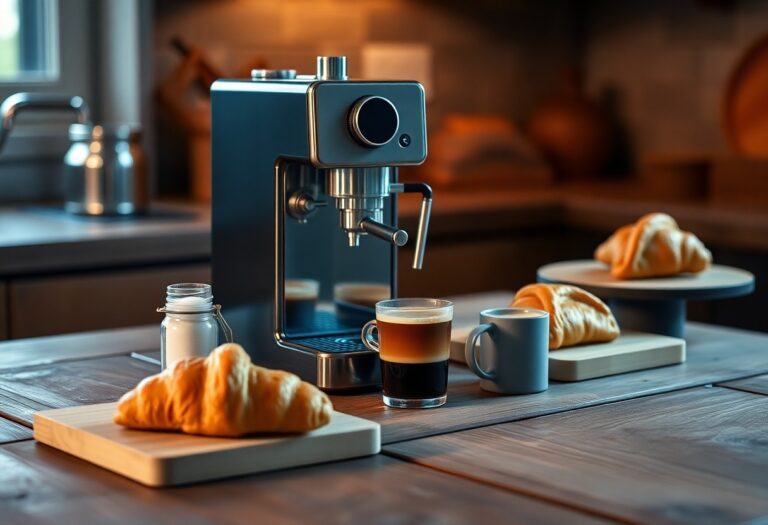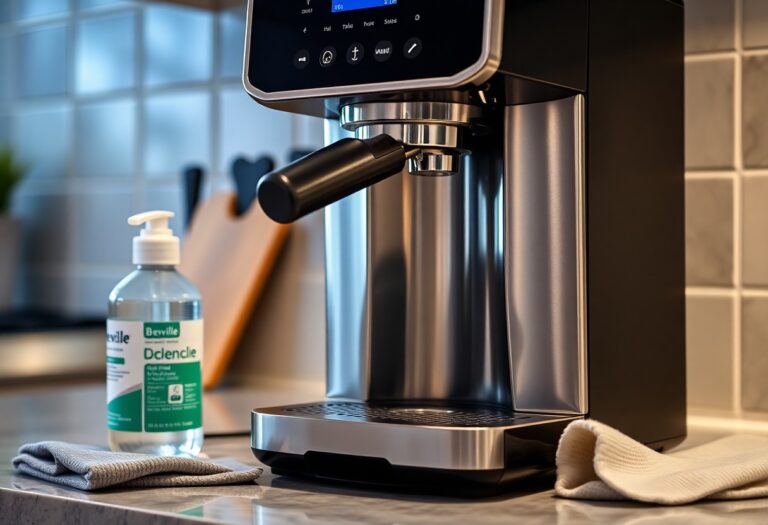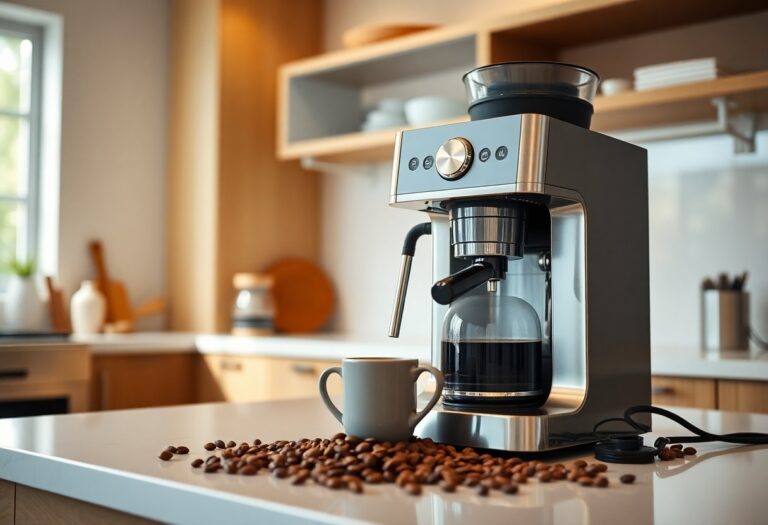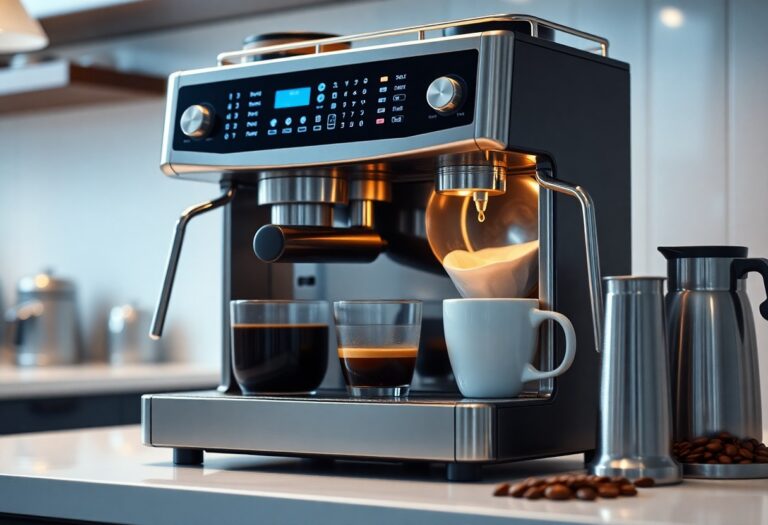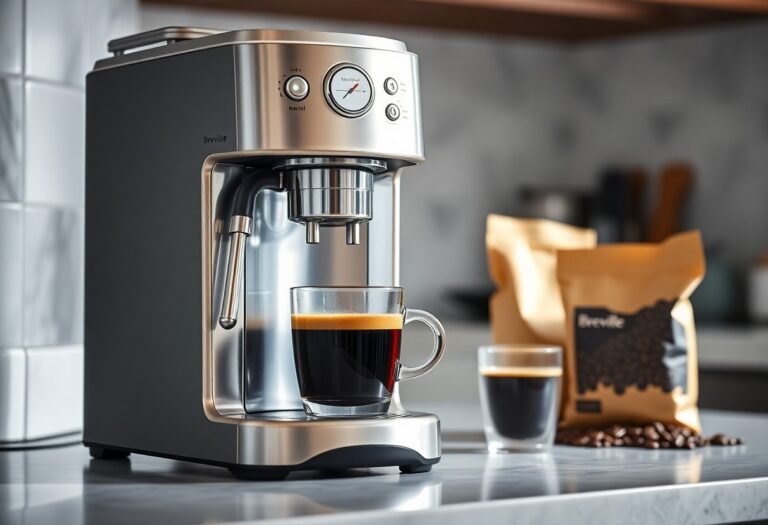What Coffee Should I Use for an Espresso Machine – Bean Recommendations
It’s crucial to choose the right coffee beans for your espresso machine to achieve that rich, full-bodied flavor you crave. When dicking out beans, consider medium to dark roasts that provide the ideal balance of acidity and sweetness. You’ll want to look for blends that are specifically labeled as espresso, as these are crafted to produce the perfect crema and robust taste. Freshness is key, so opt for whole beans and grind them just before brewing for the best results.

Key Takeaways:
- Choose beans labeled as espresso roast for a balanced flavor profile suitable for espresso extraction.
- Medium to dark roasts are often preferred for espresso due to their rich and bold flavors.
- Freshness is key; opt for freshly roasted beans and check the roast date before purchasing.
- Single-origin beans can offer unique flavor notes, while blends provide a consistent taste profile.
- Experimenting with different bean origins and roasts can help you discover your personal espresso preference.
Defining the Espresso Experience
The espresso experience revolves around a rich and complex profile that delivers not just caffeine, but a full sensory indulgence. It encompasses the intense flavor, velvety texture, and invigorating aroma that create an unparalleled moment of coffee enjoyment. With each sip, you engage with layers of taste that reflect both the beans’ origin and their roasting method, elevating your coffee ritual to a true art form.
The Essence of Espresso: Flavor and Body
A well-prepared espresso showcases robust flavors and a satisfying body, which are largely determined by the quality of the beans you choose. Look for medium to dark roasts that emphasize chocolatey, nutty, or fruity undertones while providing the necessary structure for a balanced shot. Your taste preferences will guide you in selecting beans that harmonize the complex interplay of sweetness, acidity, and bitterness.
How Beans Influence Crema and Aroma
The quality of coffee beans greatly affects the crema and aroma of your espresso, both of which contribute to a memorable drinking experience. Freshly roasted beans, particularly those with higher oil content, create a thicker, richer crema while also enhancing the overall aroma experienced with each sip.
An espresso with excellent crema forms a golden-brown layer on top, making it visually appealing and indicative of quality extraction. Beans such as Arabica varieties from Ethiopia or Colombia often produce a delightful crema due to their natural oils and sugars, which enhance the coffee’s aromatic profile. The interplay of oils and aromatic compounds releases unique scents, adding depth to the espresso experience. A well-extracted shot reveals how important your choice of beans is in achieving that perfect balance of aroma and flavor, elevating your daily ritual to new heights.
Bean Characteristics That Matter
Understanding the characteristics of coffee beans can significantly enhance your espresso experience. Factors such as roast level, origin, and processing method all influence the flavor profile of your espresso shot. Each of these attributes contributes to the balance of acidity, body, and aroma, enabling you to create a cup that suits your personal taste. Selecting the right beans means considering how these elements align with your brewing technique and the characteristics you enjoy in your espresso.
Roast Levels: Finding Your Perfect Match
The roast level of your beans greatly affects the taste of your espresso. Light roasts offer a more pronounced acidity and floral notes, while medium roasts provide a balance of sweetness and acidity, ideal for those seeking harmony in flavor. For deep, rich flavors with chocolatey or caramel notes, dark roasts are the way to go. Understanding your taste preferences will help guide you to the perfect roast level for your espresso machine, ensuring each shot is to your liking.
Bean Varieties: Arabica vs. Robusta
Choosing between Arabica and Robusta beans can significantly influence the quality of your espresso. Arabica beans are known for their smooth, nuanced flavors and vibrant acidity, making them the preferred choice for premium espresso. In contrast, Robusta beans provide a stronger, more bitter flavor and higher caffeine content, offering a different drinking experience. By understanding the characteristics of each variety, you can select the beans that best match your espresso preferences.
Arabica beans account for about 60-70% of global coffee production, favored for their complex taste profiles that exhibit fruit and floral notes. Robusta beans, on the other hand, are hardier and thrive in varied conditions, leading to their higher caffeine levels and earthy, bitter flavor. Espresso enthusiasts often prefer Arabica for its smoother finish, while Robusta can be blended in to add body and crema to your shot. Experimenting with blends can yield exciting results, giving you the opportunity to explore the full spectrum of flavors each bean variety has to offer.
The Art of Blend Selection
Selecting the perfect coffee blend for your espresso machine is both a science and an art. The ideal blend balances various flavor notes to create the rich, complex tastes that espresso aficionados crave. A well-thought-out blend can elevate your espresso experience, enhancing both aroma and mouthfeel. Exploring different beans and combinations allows you to tailor your espresso shots to suit your unique preferences.
Single Origin vs. Blends: Pros and Cons
Choosing between single-origin coffees and blends is a significant decision in the espresso crafting process. Each option has its strengths and weaknesses, impacting flavor and aroma.
Pros and Cons
| Single Origin | Blends |
|---|---|
| Showcases unique flavor profiles of a specific region. | Creates complexity with multiple flavor notes. |
| Consistency across batches may vary. | Offers consistency from established roasters. |
| May have specific seasonal availability. | Available year-round, ensuring reliability. |
| Authentic taste of different coffee-growing areas. | Allows for creative mixing techniques. |
| Typically has a cleaner taste profile. | Can balance out undesirable flavors. |
Flavor Profiles That Pair Well with Espresso
Certain flavor profiles complement espresso beautifully, enhancing your drinking experience. Look for beans that bring forth flavors like chocolate, caramel, and nutty notes, as they harmonize well with the rich, bold nature of espresso. Fruity undertones can add a refreshing twist, while a hint of spice or floral can elevate the complexity of your cup. Experimenting with various profiles leads to discovering your perfect blend, ultimately refining your espresso craft.
Where to Source Quality Beans
Finding quality coffee beans for your espresso machine can make a substantial difference in both flavor and experience. Start by exploring local markets, specialty coffee shops, and dedicated online retailers that pride themselves on sourcing top-notch beans. Often, the journey begins by connecting with reputable suppliers who emphasize direct trade and ethical practices, ensuring you’re not just getting a great brew, but supporting responsible farming as well.
Artisan Roasters: Supporting Craftsmanship
Artisan roasters take great care in selecting and roasting beans, often experimenting with small batches to achieve distinct flavors. By choosing artisan brands, you’re not only supporting local businesses but also enjoying unique, high-quality beans that are fresher than mass-produced options. Look for roasters who offer tasting notes to better match your palate with their creations.
Online Retailers vs. Local Shops: Weighing Your Options
Shopping for coffee can often boil down to a choice between local shops and online retailers. While local shops provide the advantage of fresh selections and personalized recommendations, online retailers often have a broader range, enabling you to compare brands, flavors, and prices efficiently. Additionally, many online services offer subscriptions that deliver fresh beans to your door regularly, ensuring you never run out of your favorite espresso blends.
Local shops allow you to engage directly with knowledgeable staff who can guide your choices based on their firsthand experience with the beans, enhancing your discovery process. On the flip side, online retailers frequently stock limited-time offerings and rare finds that local shops may not be able to showcase. Balancing both options could be ideal; visit local shops for fresh necessarys while exploring online for unique, high-quality beans that might not be available in your area.

Expert Recommendations: Top Beans for Espresso Enthusiasts
For those seeking the finest espresso experience, Best Espresso Beans in 2025: My 10 Current Favorites offers a curated selection suited for any palate. Renowned for their rich flavors and consistent quality, these beans from various regions provide a perfect balance of acidity, sweetness, and body. Whether you prefer a traditional Italian roast or a modern, vibrant blend, exploring these recommendations will elevate your espresso game.
Renowned Roasters and Their Signature Blends
Top-tier roasters like Illy and Lavazza have perfected their signature blends to enhance the espresso experience. Illy’s Classico blend offers a harmonious mix of Arabica beans, showcasing a floral aroma with hints of chocolate. Lavazza’s Super Crema features a perfect balance of Brazilian and Indonesian beans, delivering sweet and creamy espresso shots. These blends represent the excellence you can expect from seasoned roasters, making them staples in espresso aficionados’ collections.
Up-and-Coming Beans to Watch
Emerging roasters are constantly pushing the boundaries of flavor, making their offerings worth exploring. Brands such as Onyx Coffee Lab and Heart Coffee Roasters are gaining recognition for their innovative approaches, sourcing unique single-origin beans that provide exceptional taste profiles. Their dedication to crafting distinct flavors while prioritizing sustainability and ethical sourcing further enhances their appeal among discerning espresso lovers.
On the horizon, beans like the naturally processed Ethiopian coffees from Onyx Coffee Lab showcase vibrant fruity notes combined with an enticing complexity that brings excitement to your espresso shots. On the other hand, Heart Coffee Roasters focuses on lighter roasts that emphasize clarity and vibrant acidity, resulting in a refreshing espresso experience. These up-and-coming beans reflect the evolving landscape of coffee, providing new flavors for you to discover and enjoy in your espresso machine.
Summing up
Presently, selecting the right coffee for your espresso machine can significantly enhance your brewing experience. You should opt for freshly roasted, high-quality beans with a medium to dark roast profile, as they tend to produce the rich and complex flavors typical of espresso. Popular choices include Arabica beans for sweetness and brightness, while Robusta can add body and crema. Always consider trying blends from reputable roasters, as they often offer unique flavor profiles that can elevate your espresso. Ultimately, experimentation will help you find the perfect beans that match your taste preferences.
FAQ
Q: What type of coffee beans are best for an espresso machine?
A: The best coffee beans for an espresso machine are typically dark roast beans, as they tend to offer a rich, bold flavor that stands up well to the espresso brewing process. However, medium roasts can also work well depending on personal taste. Espresso blends, which combine various bean origins and roasts, are often recommended for a balanced flavor profile.
Q: Should I choose arabica or robusta beans for espresso?
A: Generally, arabica beans are preferred for espresso due to their sweeter and more complex flavor notes. They contain less caffeine and acidity compared to robusta beans. However, using a blend of both can result in a crema that is thicker and more robust, delivering a different but enjoyable flavor experience.
Q: How fresh should the coffee beans be for making espresso?
A: Freshness is key when it comes to brewing espresso. It is recommended to use coffee beans that have been roasted within the last two to four weeks for optimal flavor. Once opened, coffee should ideally be used within two weeks for the best taste. Storing beans in a cool, airtight container away from light and moisture can help maintain freshness.
Q: What grind size should I use for espresso beans?
A: The grind size for espresso should be very fine, resembling table salt or slightly finer. This fine grind allows for the water to properly extract flavors during the short brewing time (around 25-30 seconds) that espresso requires. Adjusting the grind size may be necessary based on the specific machine and beans used, so experimentation can be beneficial.
Q: Are there any specific regions known for great espresso beans?
A: Yes, certain regions are renowned for producing high-quality coffee beans suited for espresso. Beans from regions like South America (particularly Brazil and Colombia), East Africa (such as Ethiopia and Kenya), and Central America (like Guatemala) are often favored for their unique flavor profiles. Each region offers distinct characteristics that can enhance the espresso experience, making personal preference a vital part of selecting beans.


